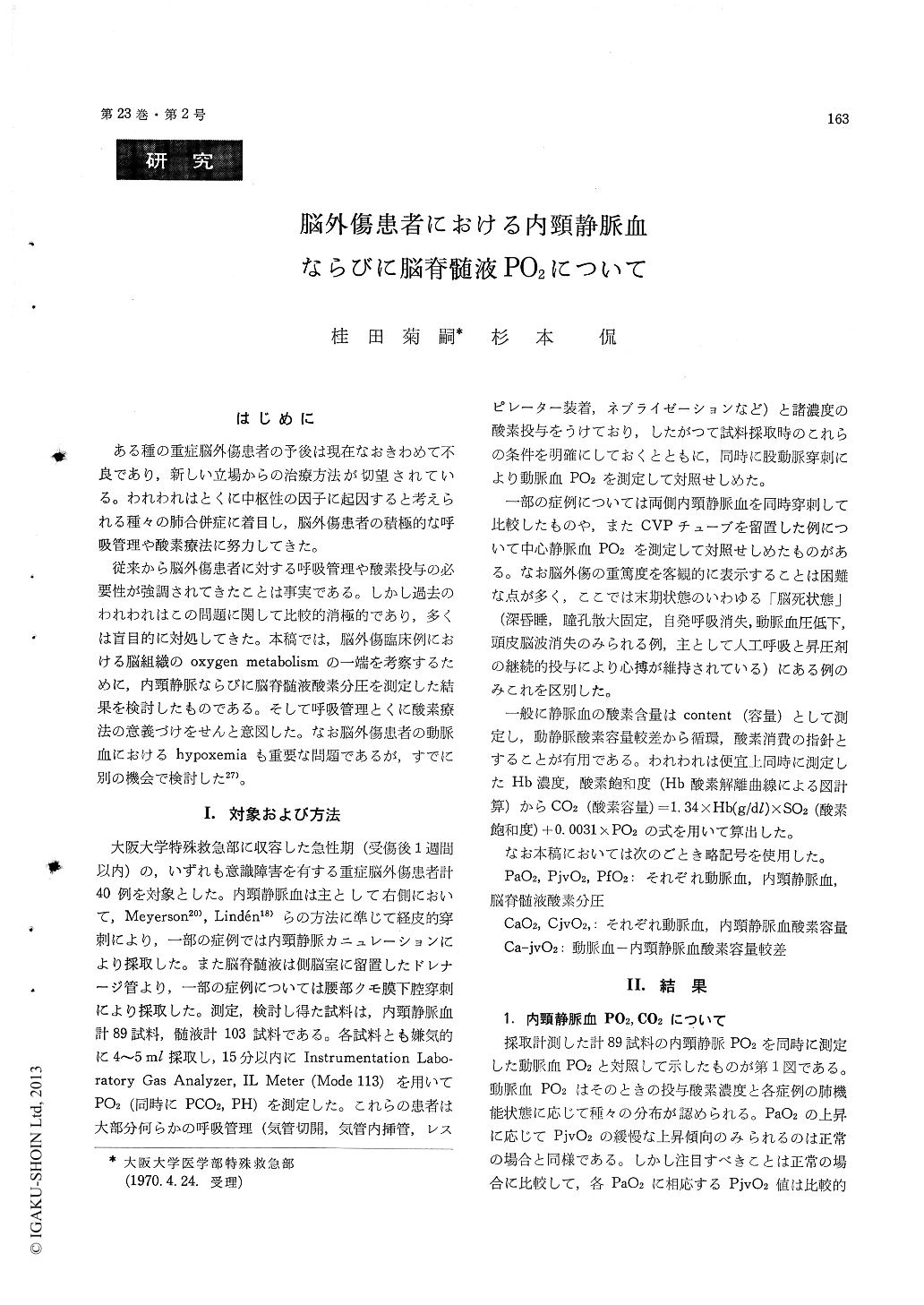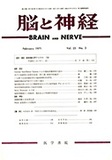Japanese
English
- 有料閲覧
- Abstract 文献概要
- 1ページ目 Look Inside
はじめに
ある種の重症脳外傷患者の予後は現在なおきわめて不良であり,新しい立場からの治療方法が切望されている。われわれはとくに中枢性の因子に起因すると考えられる種々の肺合併症に着目し,脳外傷患者の積極的な呼吸管理や酸素療法に努力してきた。
従来から脳外傷患者に対する呼吸管理や酸素投与の必要性が強調されてきたことは事実である。しかし過去のわれわれはこの問題に関して比較的消極的であり,多くは盲目的に対処してきた。本稿では,脳外傷臨床例における脳組織のoxygen metabolismの一端を考察するために,内頸静脈ならびに脳脊髄液酸素分圧を測定した結果を検討したものである。そして呼吸管理とくに酸素療法の意義づけをせんと意図した。なお脳外傷患者の動脈血におけるhypoxemiaも重要な問題であるが,すでに別の機会で検討した27)。
This work was undertaken to clarify some aspect of cerebral metabolism in severe head injury, with special reference to oxygen tension of internal jugular venous blood (jv) and cerebrospinal fluid (f).
Of 40 unconscious patients, suffered acute head injury (within seven days after injury), internal jugular venous blood (total 89 samples) was obtained by percutaneous puncture, and csf (total 103 samples) from lumbar subarachnoid space or lateral ventricle through inserted cannula. P02 was measured by IL Meter, and CO2 (oxygen content) was calculated from Hb, SO2 and P02. Each values were compared with simultaneously obtained arterial (a) levels.
Pa02 was diversified in a wide range, reflecting pulmonary function of each patients and admini-strated oxygen concentration. PjvO2 was mostly distributed from 20 to 60 mmHg, but severest cases or so-called brain death syndrome showed markedly high PjvO2.
So far as oxygen content is concerned, the botharterial and jugular venous CO2 was decreased. And narrowed arterio-jugular venous CO2 difference was common finding in injured brains. In brain death state, the narrowing of CO2 difference was extinctive (mean 1.6 vol. %), when their PjvO2 exceeded mixed venous P02 and PCO2 decreased closely to arterial PCO2. These findings were ir-respective of oxygen treatment, even at high PaO2 or normal CO2 values. An attempt of enriched oxygen administration unusually changed a-jv 02 difference.
Both sides of internal jugular bulb were punctured in some patients. Two cases, who had unilateral extradural hematoma, showed lower PH, increased PCO2 and wider CO2 difference in ipsilateral jugular venous blood.
Cerebrospinal fluid PO2 (varied from 15 to 90 mmHg) was related to coincidental values of PaO2. In a higher range of PaO2, however, increment of PfO2 was restricted and then PfO2/PaO2 ratio was significantly reduced than normal. In ordinary range of PaO2 (70-100 mmHg), more than 50 % of PfO2 did not exceed 40 mmHg. Following enriched oxygen administration, remarkable rise of PfO2 was obtained in a few patients, that was associated with widening of a-jv CO2 difference.
The effect of hyperbaric oxygenation upon PfO2 was investigated in 11 patients. Under hyperbaric conditions (2 ATA, 100% oxygen), Pf02 were ele-vated to 97-490 mmHg.
COMMENT : Arterial hypoxemia and csf hypoxia in head injured patients may require oxygen treat-ment. But reduced cerebral oxygen untilization appears to be independent of oxygen pressure gradi-ent between arterial blood and tissue. It seems important to throw light on the underlying path-ology of cerecral peripheral circulation, that is prime cause of tissue hypoxia. We advocated a hypothetic condition that any forms of arterio-venous shunt-ing in brain or skull might play a role in these circumstances.

Copyright © 1971, Igaku-Shoin Ltd. All rights reserved.


